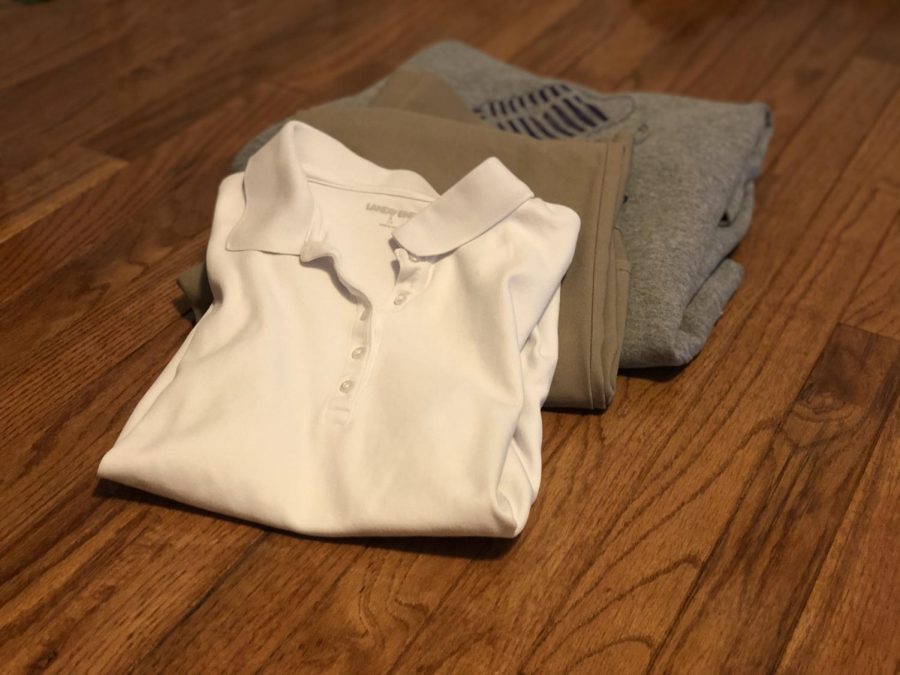New Dress Code Enforcement Policy Prompts Varying Opinions From Students and Teachers
NEW DRESS CODE ENFORCEMENT POLICY PROMPTS VARYING RESPONSES FROM TEACHERS AND STUDENTS — The Central dress code consists of khaki pants, grade level colored polo, and school colored and approved outerwear.
December 2, 2021
A new dress code enforcement policy at Central has been likened to speeding and traffic lights enforced by camera. It has been referred to as “majoring on the minor,” considering dress code one of the lesser important facets of a student’s high school experience.
After students and teachers returned from Fall Break on October 18, a new dress code enforcement policy was introduced. It states that if a teacher sees a student out of dress code in any way, from an absent polo to the wrong colored outerwear, they are encouraged to put the student’s name on a spreadsheet. After this, an administrator will contact the student for their punishment or attempt to correct the dress code violation. The punishments are progressively severe after each dress code violation.
“Consequence #1: Parent Contact/Conference/ISS; Consequence #2: Parent Contact/ 2 days ISS; Consequence #3 Parent Contact/ Suspension up to 5 days; Consequence #4 Parent Contact/ Suspension up to 10 days,” the new policy states.
When asked for an interview concerning the change in policy, Principal Phil Iannarone sent the following reply:
“One purpose of our dress code is to provide guidance to the school community regarding appropriate attire. The dress code is also a means of teaching students a life skill in how to present yourself while you embody the culture of the larger community.”
Teachers do not have to notify students concerning their dress code violation, nor do they have to give students an opportunity to get in correct dress code. Some teachers, including Shawn Seals, U.S. History teacher and Champion yearbook sponsor, appreciate the new system as a simple and uniform way to enforce the school’s dress code. He expressed how it allows for class to continue running smoothly while also addressing the issue of out of dress code students.
“I think it helps with class time because we don’t have to interrupt anything; it is a better way to keep it enforced,” Seals states.
While understanding reasons the dress code should be enforced, several students disagree with this manner of enforcement due to the way it keeps students uninformed and powerless to fix their mistakes.
“I don’t think [teachers] should be allowed not to tell you [that you’re being referred to the office] because students should be given a chance to fix it,” expressed Riley Hayden, a Junior at Central.
Central’s ISS monitor, Dillard Hawkins, is witnessing the effectiveness of the new policy. The ISS classroom is near its capacity almost every day on a consistent basis.
“It seems to be an ongoing problem. It’s not changing much at all,” Hawkins explains.
While in ISS, students are encouraged to do their work by checking Canvas (where online assignments are posted) and to stay out of ISS in the future by preparing their uniform every night before school.
“The punishment seems a little extreme. People are in ISS and that is taking away from class time,” stated Sydney Tory, a Junior. “I don’t believe [the way we dress] changes our behavior; it doesn’t have anything to do with our behavior.”
There could be many reasons why a student is out of dress code: choosing not to wear a polo (or other violations) due to personal dislikes, not being in possession of (or an appropriate number of) dress code components, or not preparing their clothes the night before (i.e. clothes are still in the washer).
“[The dress code] erases our individuality,” student Makayla Hadland said.
One student noted the difference between Central’s dress code and other surrounding high schools. For example, Hixson, East Hamilton, and Ooltewah, and Tyner all have very different dress codes. It is up to each school’s administration to come up with ‘appropriate school attire’. Different schools choose different things to allow, regulate and ban, varying from leggings, skirts, color of shirts, tank tops, pant color, boots, sandals, and rips in jeans. No two high schools in Hamilton county address the issue of ‘appropriate school attire’ in the same way. There is definitely a lack of consistency throughout Hamilton County concerning this issue.
School dress codes must consider and balance the complex issues of appropriate attire, resources available to students, school safety, and individual expression. Understanding there are trade-offs to compensate for each of these issues goes a long way to explain the discrepancy between the county’s high school dress codes.
“I’m looking to the future: [We should] get a bundle of each color of collared shirt in different sizes, not just to give to everybody in the school building one, but to those who are lacking a school uniform,” Hawkins explained, suggesting a way for the community to support students at Central High School.
Whether it is best to keep or change the current dress code, school rules should still be followed. Dress code remains a controversial topic; however, students and faculty should continue to listen to one another’s opinions on the issue.





